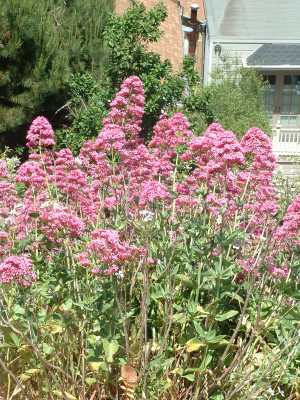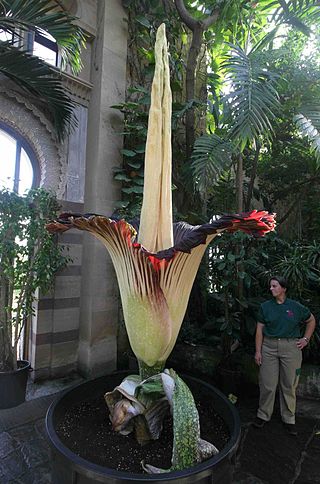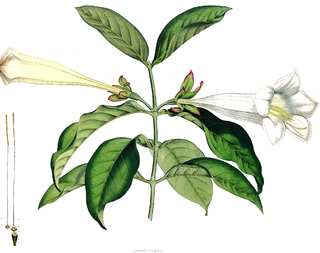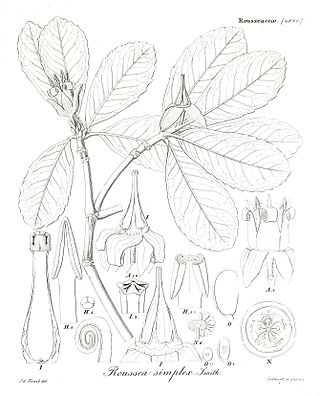
The family Asteraceae, with the original name Compositae, consists of over 32,000 known species of flowering plants in over 1,900 genera within the order Asterales. Commonly referred to as the aster, daisy, composite, or sunflower family, Compositae were first described in the year 1740. The number of species in Asteraceae is rivaled only by the Orchidaceae, and which is the larger family is unclear as the quantity of extant species in each family is unknown.

Dactylanthus taylorii, commonly known in English as wood rose and in Māori as te pua o te rēinga, is a fully parasitic flowering plant, the only one endemic to New Zealand. The host tree responds to the presence of Dactylanthus by forming a burl-like structure that resembles a fluted wooden rose. When the flowers emerge on the forest floor, they are pollinated by a ground-foraging species of native bat.

A frugivore is an animal that thrives mostly on raw fruits or succulent fruit-like produce of plants such as roots, shoots, nuts and seeds. Approximately 20% of mammalian herbivores eat fruit. Frugivores are highly dependent on the abundance and nutritional composition of fruits. Frugivores can benefit or hinder fruit-producing plants by either dispersing or destroying their seeds through digestion. When both the fruit-producing plant and the frugivore benefit by fruit-eating behavior the interaction is a form of mutualism.

In botany, a perennial plant or simply perennial is a plant that lives more than two years. The term is often used to differentiate a plant from shorter-lived annuals and biennials. The term is also widely used to distinguish plants with little or no woody growth from trees and shrubs, which are also technically perennials. Notably, it is estimated that 94% of plant species fall under the category of perennials, underscoring the prevalence of plants with lifespans exceeding two years in the botanical world.

Leucospermum is a genus of evergreen upright, sometimes creeping shrubs that is assigned to the Proteaceae, with currently forty-eight known species.

Centranthus ruber, the red valerian, spur valerian, kiss-me-quick, fox's brush, devil's beard or Jupiter's beard, is a popular garden plant grown for its ornamental flowers.

Zoophily, or zoogamy, is a form of pollination whereby pollen is transferred by animals, usually by invertebrates but in some cases vertebrates, particularly birds and bats, but also by other animals. Zoophilous species frequently have evolved mechanisms to make themselves more appealing to the particular type of pollinator, e.g. brightly colored or scented flowers, nectar, and appealing shapes and patterns. These plant-animal relationships are often mutually beneficial because of the food source provided in exchange for pollination.

Chamaerops is a genus of flowering plants in the family Arecaceae. It contains only one species, Chamaerops humilis, variously called European fan palm or the Mediterranean dwarf palm. It is one of the most cold-hardy palms and is used in landscaping in temperate climates.

Carrion flowers, also known as corpse flowers or stinking flowers, are mimetic flowers that emit an odor that smells like rotting flesh. Apart from the scent, carrion flowers often display additional characteristics that contribute to the mimesis of a decaying corpse. These include their specific coloration, the presence of setae and orifice-like flower architecture. Carrion flowers attract mostly scavenging flies and beetles as pollinators. Some species may trap the insects temporarily to ensure the gathering and transfer of pollen.

Hydnoroideae is a subfamily of parasitic flowering plants in the order Piperales. Traditionally, and as recently as the APG III system it given family rank under the name Hydnoraceae. It is now submerged in the Aristolochiaceae. It contains two genera, Hydnora and Prosopanche:

A flower, also known as a bloom or blossom, is the reproductive structure found in flowering plants. Flowers consist of a combination of vegetative organs – sepals that enclose and protect the developing flower, petals that attract pollinators, and reproductive organs that produce gametophytes, which in flowering plants produce gametes. The male gametophytes, which produce sperm, are enclosed within pollen grains produced in the anthers. The female gametophytes are contained within the ovules produced in the carpels.

Banksia grossa is a species of shrub in the family Proteaceae and is endemic to Southwest Australia. It is one of fourteen species of banksia of the series Abietinae, all of which bear predominantly cylindrical or oval inflorescences. Collected in 1965, it was first formally described in 1981 by Alex George. Its thick leaves and large seeds distinguish it from other members of the Abietinae, and are the basis of its species name.
Plant reproduction is the production of new offspring in plants, which can be accomplished by sexual or asexual reproduction. Sexual reproduction produces offspring by the fusion of gametes, resulting in offspring genetically different from either parent. Asexual reproduction produces new individuals without the fusion of gametes, resulting in clonal plants that are genetically identical to the parent plant and each other, unless mutations occur.

Vaccinium ovatum is a North American species of flowering shrub known by the common names evergreen huckleberry, winter huckleberry, cynamoka berry and California huckleberry. Vaccinium ovatum is classified in phylum: Magnoliaphyta, order: Ericales, family: Ericaceae, genus: Vaccinium, and species: ovatum.

Portlandia grandiflora is a species of plant in the family Rubiaceae. Commonly known as the bell flower, this plant is considered native to Jamaica but is also native to Cuba. It is mainly found in limestone montane forests although some occur on karst areas near Jamaica's coast. It mostly grows on alkaline soils as can be observed by the habitats they are found in. In Jamaica, they flower most frequently in May, June, and August, and fruit during the months of January and December.

Insect ecology is the interaction of insects, individually or as a community, with the surrounding environment or ecosystem.

Cytinus is a genus of parasitic flowering plants. Species in this genus do not produce chlorophyll, but rely fully on its host plant. Cytinus usually parasitizes Cistus and Halimium, two genera of plants in the family Cistaceae. It has also been found on Ptilostemon chamaepeuce.
Seed dispersal syndromes are morphological characters of seeds correlated to particular seed dispersal agents. Dispersal is the event by which individuals move from the site of their parents to establish in a new area. A seed disperser is the vector by which a seed moves from its parent to the resting place where the individual will establish, for instance an animal. Similar to the term syndrome, a diaspore is a morphological functional unit of a seed for dispersal purposes.

Pyrus bourgaeana, the Iberian pear, is a close relative of Pyrus communis L. The latter was domesticated about 2500 years ago. This small tree is widely distributed across the southern Iberian Peninsula and northern Morocco, where it coexists with four Pyrus species: P. communis L., P. cordata Dew., P. spinosa Forssk, and P. nivalis Jacq. Characteristics to discriminate these species are the width of fruit peduncle, petal size, leaf width and petiole length served to the taxa.

Roussea simplex is a woody climber of 4–6 m high, that is endemic to the mountain forest of Mauritius. It is the only species of the genus Roussea, which is assigned to the family Rousseaceae. It has opposing, entire, obovate, green leaves, with modest teeth towards the tip and mostly pentamerous, drooping flowers with yellowish recurved tepals, and a purse-shaped orange corolla with strongly recurved narrowly triangular lobes.

















